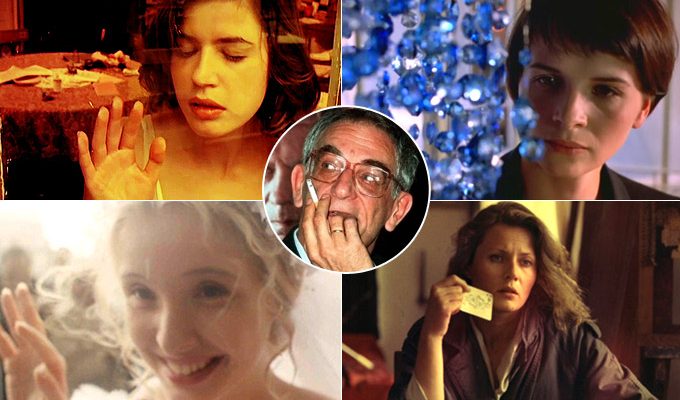 “The Double Life Of Veronique” (1991)
“The Double Life Of Veronique” (1991)
“The realms of superstition, fortune-telling, presentiments, intuition, dreams, and the inner life of a human being…all this is the hardest thing to film,” Kieslowski once said. “Because [these themes] deal with things you cannot name. If you do they seem trivial and stupid.” Featuring a bifurcated narrative, ‘Veronique’ centers on two separate women — each played by Irene Jacob (who would win the Best Actress prize at Cannes) — raised in different countries with a mysterious bond connecting them. Identical doppelgangers or the same person? Weronika is a singer in Poland with a weak heart and Veronique is a Polish music teacher. Ostensibly the same person (or maybe not), Weronika dies of a heart attack mid-recital after seeing her identical other half briefly in a Krakow square (ironically at a demonstration about solidarity). Unaware of Weronika’s existence, Veronique nonetheless is struck with a deep sense of loss, isolation and grief after her other half passes on. This death reverberates like an echo throughout her, leading to quit her job and transform her life (themes of manipulation, inverted worlds and freedom are all felt). Expressively shot in intimate, melancholic close up of its protagonists — with radiant amber hues imbuing each frame — “The Double Life Of Veronique” is a sensual, enchanting and profoundly absorbing contemplation of Kieslowski’s singular preoccupation with the unfathomable and enigmatic interconnectedness of human existence. The distinct musical presence of Zbignew Preisner and the memorable gold color palette by cinematographer Slawomir Idziak all forecast hints of what was to come in Three Colors. Extra credit: fate and chance intervened on Kieslowski himself as such forces helped to narrowly avoid the original casting choice of Andie Macdowell in the role of Veronique/Weronika.
 “Three Colors: Blue” (1993)
“Three Colors: Blue” (1993)
Kieslowski’s final troika, the Three Colors trilogy explored the themes of the three colors represented in the French Flag, liberty, equality, and fraternity through three, seemingly unrelated and unconnected individuals (the filmmaker acknowledged the pictures were French because of the funding, but would have been the same under any nationality). For each film, Kieslowski would use a different female protagonist and three different cinematographers to give the films a distinctive look. In his first chapter, “Blue,” arguably the most emotionally devastating of the three, Juliette Binoche stars as Julie, and the sole survivor of a car crash that has killed her daughter and husband, a famous composer. Left to pick up the pieces, Julie initially doesn’t possess the will to go on, but it’s strong enough that she can’t even go through a suicide attempt. Attempting to live a dissociative existence and sever ties to her past, Julie begins to discard the possessions of her life in order to be free and begin again save for a chandelier of blue beads owned by her daughter. Yet the past manages to be tricky to elude and a former assistant of her late husband turns up, interested in the condition of an unfinished musical composition, commissioned by the government to celebrate European unity (it’s strongly implied throughout that Julie wrote or co-wrote some of this music). Appropriately, “Blue,” is marked by its extraordinary score that often arrives in evocative snatches of orchestral grandeur and the striking sapphire color palate of cinematographer Slawomir Idziak. Sensual, operatic and haunting, “Blue” is a crucial film in this final masterwork.
 “Three Colors: White” (1994)
“Three Colors: White” (1994)
Regarded as (and often unfairly dismissed as) the least essential film in the Three Colors trilogy, due to its lighter and more comedic tone, “White” undeniably does not carry the same emotional weight and sense of mysterious import as the triptych’s bookends, but the picture is still nonetheless, an engaging and unlikely diverting treat from the director. Focusing on the theme of equality (and or the lack thereof in this case; Kieslowski’s thematic riffs were hardly linear and often sarcastic), Kieslowski’s black sheep and second film of his lauded trilogy is a sort of black comedy, centering on Karol, a Polish hairdresser (Zbigniew Zamachowski) whose wife (Julie Delpy) has left him due to his impotency. Humiliated, penniless and left abandoned in Paris without a passport, Karol has to make his way back to Poland and during his pilgrimage, he befriends another Pole, Mikolaj (Janusz Gajos) who wants to pay the hairdresser to kill someone who wants to die, but doesn’t have the courage to commit suicide. When Karol finally returns to Poland, his fortunes turn for the better and he begins amassing considerable wealth of which he then uses to hatch a misguided plot of revenge against his wife. A cynical and mordant examination of marriage, power and the inequalities of wealth, “White” may be the weakest of the trio, but Kieslowski still won the Silver Bear for Best Director at the 44th Berlin International Film Festival in 1994.

